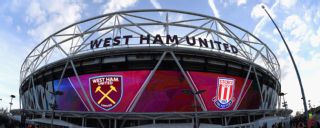|
The ICC was forced to abandon the notion of staging World Cup matches at London's Olympic Stadium next year, due to concerns that the setting sun would render one end of the pitch unusable from a playing and television perspective. Despite a clear desire to incorporate East London's iconic stadium into plans for what has been billed as the "World's Greatest Cricket Celebration", the tournament organisers were forced to admit defeat when the World Cup fixtures were confirmed by the ICC this morning. The omission was "very disappointing", said Steve Elworthy, the tournament director, who had envisaged turning the entire Olympic Park into a focal point for fans across London, with a particular emphasis on the Asian and Caribbean populations of the host borough, Newham. This decision came after an exhaustive feasibility study, which even included Andrew Strauss and Eoin Morgan shadow-batting along the three orientations - North-South, East-West and 55-degree - that had been considered for the laying of the drop-in wickets that have been prepared at Lord's and Loughborough in the lead-up to the event. Of these, the North-South option would have been the operational preference, in keeping with the majority of the other 11 selected venues, including Old Trafford - the host of the marquee India-Pakistan match - which rotated its own pitch by 90 degrees as part of a major redevelopment in 2010. However, the studies concluded that a North-South pitch would have caused too much upheaval to the architecture of the stadium, which includes permanent replay screens at both ends of the ground, both of which would be rendered unusable due to their impacting on the batsman's line of sight. That would have necessitated the erection of temporary replacement scoreboards and TV gantries, while the press facilities, currently situated on the west side of the ground, would have had to have been moved behind the bowler's arm at the southern end. The overall impact, not to mention the exorbitant costs of such a refit, would have been the loss of approximately 28,000 seats - or the equivalent of a full house at Lord's. The notion of angling the wicket at 55 degrees across the venue was ruled out for similar logistical reasons - oblique sight-screens and overflow press facilities would have had to be erected, while the spectator experience of watching from seats not directly aligned to the action would have been unsatisfactory. The only option would have been to face the setting sun, but for a left-hander such as Morgan in particular, this would have necessitated staring directly into the light for the latter part of a day-game. "The sun was a big challenge," said Morgan. "What they have at the moment is a Perspex roof, which allowed the sun to come directly over the bowler's arm, and to have it in the opposite direction would have meant a bit of a shorter boundary. There were a lot more challenges, but we did go out and have a look at it. It's a beautiful stadium." Further challenges included the repositioning of the floodlights, which have been folded in from their previous high position during the 2012 Olympics and are now just 20 metres from the ground - good for West Ham's purposes as a football club but far from ideal for high catches in cricket. And West Ham's residency caused more complications for the ICC - with a six-week turnaround required at either end of the football season creating an extremely limited window for test events. Despite from interest from Essex in particular since the stadium's inception, the venue has never yet hosted a cricket match of any length, and the likelihood of that ever now happening seems remote, at least while West Ham remain the venue's principal tenants. Despite suggestions that West Ham's under-soil heating would have been an issue for the laying of the drop-in wickets, the bigger concern for the ICC was the fear of serious injury - akin to that of Simon Jones at Brisbane in the 2002-03 Ashes - on what would have had to be a raised sand-based outfield.
|

